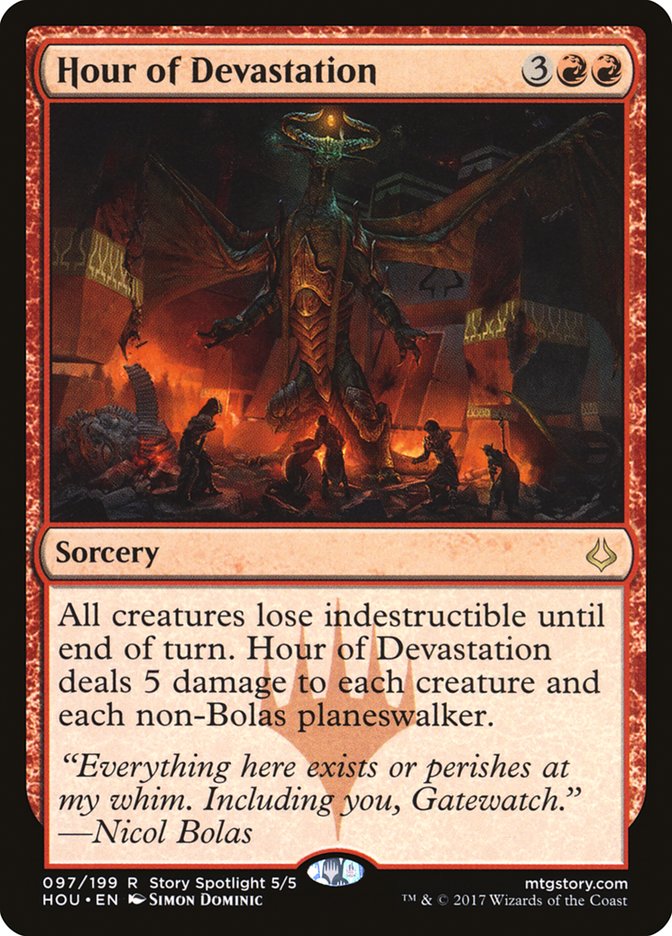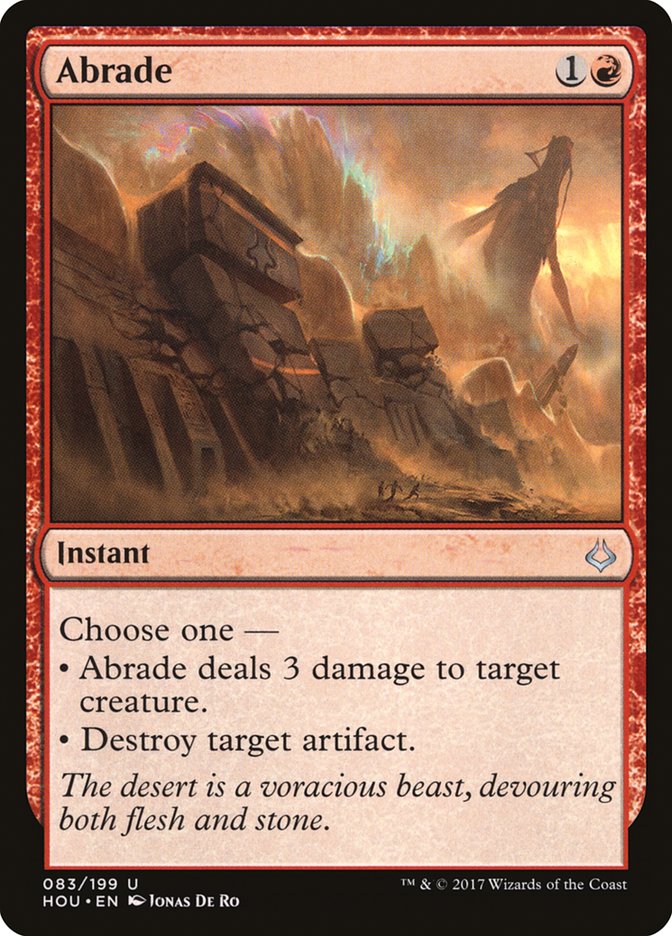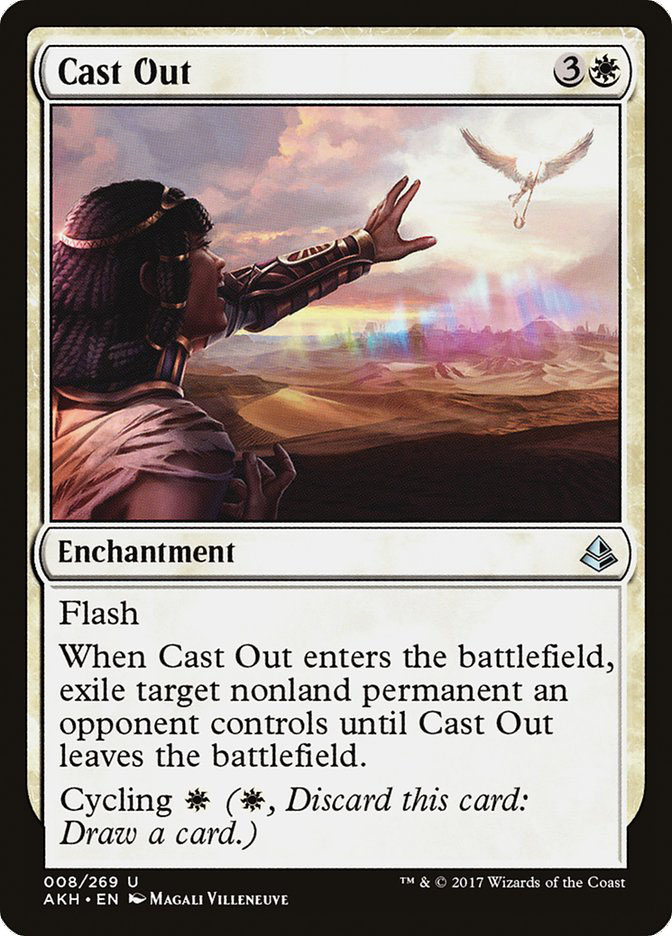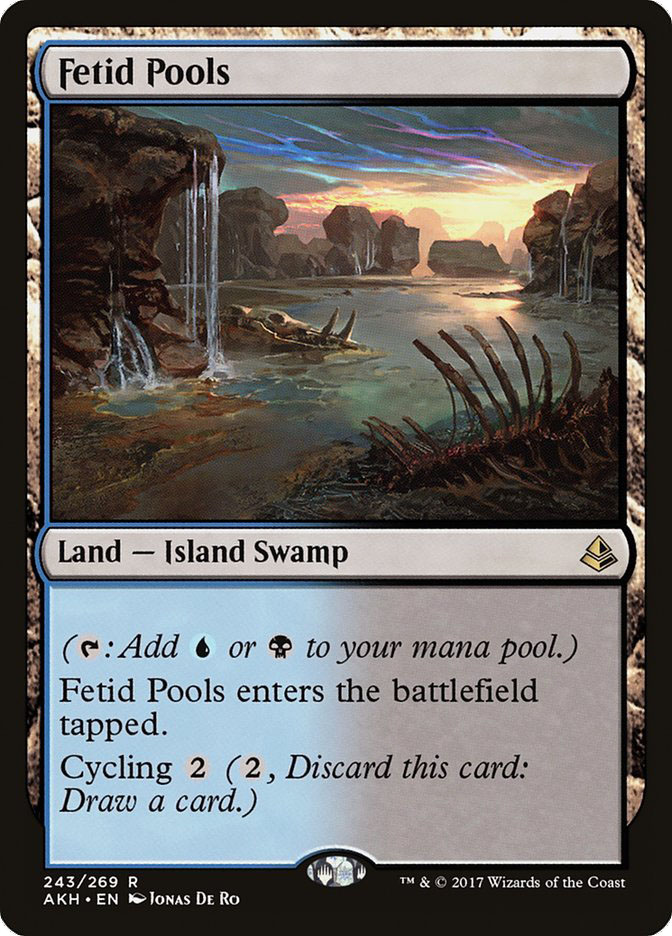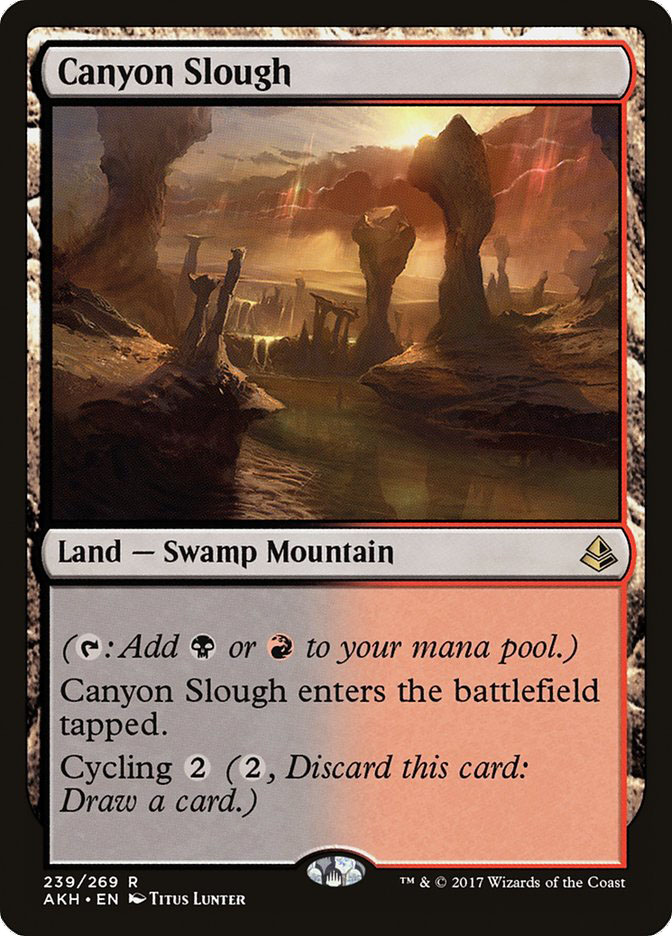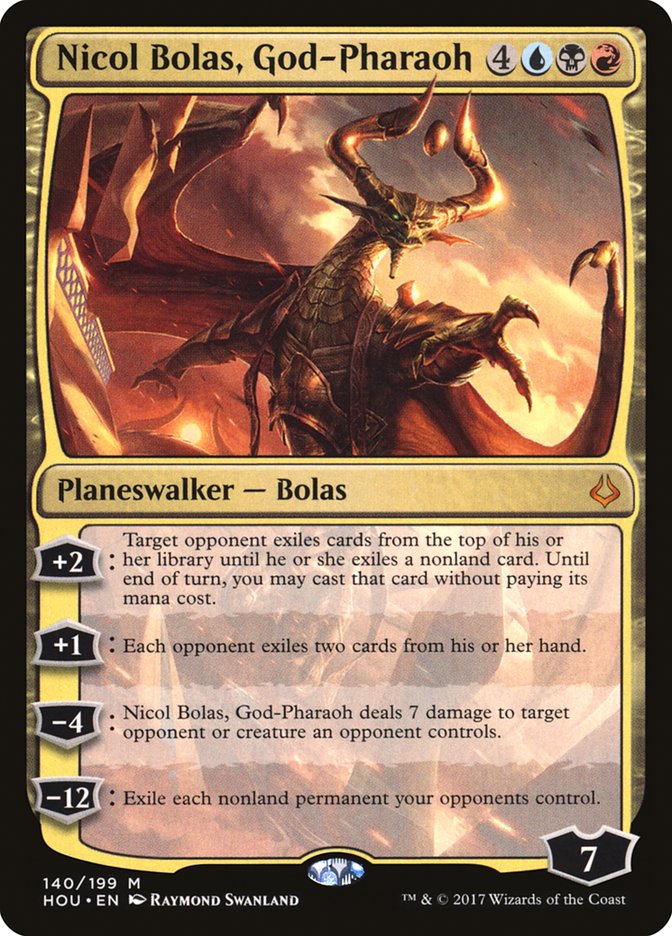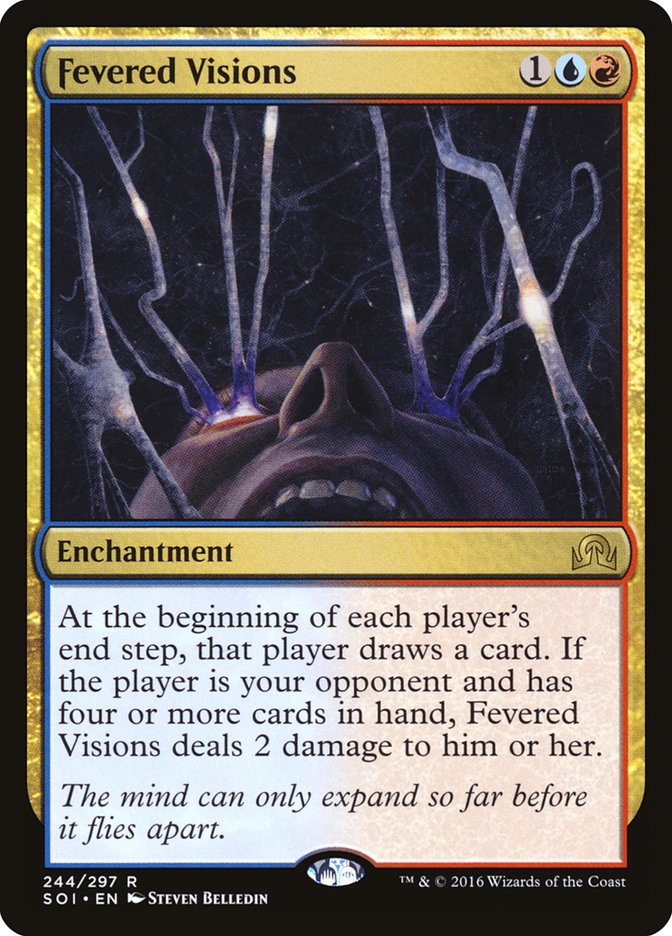Playing a copious number of games is the best way to prepare for a tournament. Period.
This weekend is the first Standard set with Hour of Devastation being legal, and I couldn’t be more excited. This is the fifth or sixth consecutive Standard release where the energy around the first Open has been palpable. People are excited, and there are a slew of amazing new cards being introduced to the format. Some of them are creating new problems for existing archetypes, and some of them are sealing leaks in what may have otherwise been a leaky hull.
A few weeks ago I wrote an article about playtesting correctly and received a lot of great feedback for it. Most of it was positive, but I also received a fair chunk of questions, most of them to the effect of “During playtesting, what are you thinking about?”
Everything in Magic is contextual, and the shortest answer to what I’m looking for during playtesting is figuring out how my cards interact with the opponent’s. I want to figure out if my cards are interacting favorably, or if I’m having to jump through hoops to make them justifiable.
That sure feels a little vague, doesn’t it?
A benefit of having two articles this week is that while my first article was a bit fluffier and more personal, I have the luxury of publishing a nuts-and-bolts article now that gets right now to business. So instead of using hypothetical anecdotes to explain how I playtest, I’m going to be more direct: I’m going to write this as I playtest for #SCGCIN.
Rather than working on my wordsmithing and flow, I’m just going to write about every game that I play and what I think and what I change about my deck along the way, all in an attempt to shed a bit of light on my process when preparing for a tournament.
The first place I started is the Jadine Klomparens B/G Energy deck from the end of her article last week:
Creatures (24)
- 3 Catacomb Sifter
- 2 Tireless Tracker
- 3 Verdurous Gearhulk
- 2 Longtusk Cub
- 4 Winding Constrictor
- 2 Rishkar, Peema Renegade
- 4 Glint-Sleeve Siphoner
- 4 Walking Ballista
Planeswalkers (4)
Lands (21)
Spells (11)

The beauty of this deck is that the deck itself is already incredibly fine-tuned and doesn’t have to do much with the release of Hour of Devastation at level zero. That’s to say that there isn’t anything in the set that jumps out and screams, “Put me in, coach!” This gives me a great springing-off point to compare other decks to as well put them through the playtesting process.
Last week, when Jadine wrote about B/G Energy, she touched on Solemnity and her hesitance to wade through a field full of it. This led me to look death in the face and playtest against the worst conceivable matchup from the get-go:
Creatures (8)
Lands (27)
Spells (25)

This deck is designed to take advantage of the Thing in the Ice / Solemnity interaction, all while getting to maindeck what is effectively a hate card in the process.
After about four hours of games with a testing partner, I came to a few conclusions about the pair of decks.
For Energy:
- Catacomb Sifter felt great. Tireless Tracker may literally be a three-drop creature, but it often plays as a four-drop, and in a deck that’s as aggressively slanted as B/G, that’s a real liability.
- Uncage the Menagerie with an X value of three feels great.
- Despite my initial skepticism, I’m on board with Jadine’s assertion that Doomfall fixes a lot of the problems that the deck has post-sideboard against Control. I’ll spare the details and just recommend you read her piece from last week.
- This deck has a lot of cards that are effectively blanks with a Solemnity on the table. Control may have invested an entire card to only reduce the power of most of Energy’s, but when the games tend to go long, that decrease in card quality matters a pretty absurd amount.
For Control:
- Three copies of Solemnity is likely the correct number, but if it’s wrong, I’d err on the side of playing less rather than more. Drawing multiple copies of the enchantment was incredibly awkward, as the redundancy doesn’t benefit the caster in any way.
- Gideon of the Trials out of the sideboard felt fine but wasn’t exciting. The initial plan was to use it with Thing in the Ice to have a more aggressive gameplan post-sideboard, but most of the decks that Gideon comes in against have a way to answer it on turn 2. Gideon’s Defeat isn’t doing this iteration of Gideon any favors, either.
- The splash for Lumbering Falls was pretty great. It’s pretty hard to deal with Lumbering Falls and it gives the deck some inevitability. I just don’t know if this is the place for it. The initial thought was that it was effectively a free splash, but with Thing in the Ice in the deck, it may just be better to have better mana or additional copies of cycling lands.
- On that note, the deck seemed to flood more than one would expect. Censor gets cycled pretty frequently, and the odds of it going from probably-blank to stone-blank are pretty high. With both Supreme Will and Glimmer of Genius in the deck, it’s likely possible that control decks can look to cheat on their lands more frequently.
- Pull from Tomorrow wasn’t missed. Solemnity and Thing in the Ice are already relatively conditional on when they’re good, and adding more cards in that vein to the mix is a recipe for disaster.
One thing that impressed me about U/W was the blue side of the deck. The curve of “tapped land, answer, answer, Glimmer of Genius, answer, Torrential Gearhulk” is likely just as good as it was before, but now there are new toys to add to the mix:
It’s no secret that I’ve been a fan of Jeskai Control for a few months, particularly in favor of U/R. This always begged the question: Why Jeskai over U/R? It’s elementary, dear Watson:
Cast Out was a great way to answer things that traditional counterspells might have trouble dealing with. Sometimes you tap out at an inopportune time and Archangel Avacyn slips through. Maybe a Gideon, Ally of Zendikar found his way onto the battlefield with the help of his good friend Lay Bare the Heart. Whatever the issue was, Cast Out could act as a safety net.
Now, Hour of Devastation has given us Hour of Devastation (ba-zing!).
This fixes a lot of problems that Control decks had in Standard. It isn’t going to fix everything, but it sure will put you back in a game where you may otherwise be incredibly far behind.
Creatures (4)
Lands (25)
Spells (31)

This deck is pretty basic, but it’s pushing the new card from Hour of Devastation at the forefront of what it’s doing. In a large number of scenarios it’s easy to imagine Abrade being better than Harnessed Lightning. The split in favor of Abrade is to draw it more frequently during playtesting and see how it fares in as many situations as possible.
Due to timing constraints, from this point I’ll just be playing in Magic Online Leagues for playtesting.
League 1, Match 1, U/R Control Mirror
I have a theory in this mirror match. The first game is exclusively about decking the opponent the hard way. I’m sure I’ll come to regret posting this in an article, but generally speaking, these decks have either eight or nine total threats in the deck, and both players have roughly 25 answers. Killing the opponent just isn’t possible a fair chunk of the time. The first game involves me decking the opponent and getting value out of Hour of Devastation to kill a Chandra, Flamecaller. That’s a huge strike against the sideboard copy of Chandra and makes me wonder if it would be better to have a different anti-Zombie card or better anti-control card.
Post-sideboard involved us trading games, with their Glorybringers destroying copies of Thing in the Ice that I had in the deck. I’m starting to get pretty cold on the current anti-control threats that the deck is currently sideboarding. It’s possible that this changes, but having things that die so easily is not where I want to be. Sphinx of the Final Word dying to Hour of Devastation is a huge knock against it as well.
Abrade was significantly better than Harnessed Lightning in this matchup. Shattering a Torrential Gearhulk or burning a Wandering Fumarole is an exceptional split card.
League 1, Match 2, U/R Control Mirror
Killed all of the opponent’s threats again and won the first game in relatively easy fashion. It’s important to note that I’m letting draw spells resolve and only casting mine when I’ll still have more cards left in deck if it resolves. I never fire up Wandering Fumarole because it just turns Magma Spray into an incredible Sinkhole.
This opponent has The Locust God post-sideboard, and I can’t imagine that being correct. Having to tap out for it just seems super-rough, and it being countered by so many things isn’t giving it any points. Jace’s Defeat was great and it felt wonderful not having to trim copies of my removal spell (Abrade) due to the number of applications it has against creature-lands, Dragonmaster Outcast, and Torrential Gearhulk.
League 1, Match 3, G/R Energy
Bristling Hydra still gives Control decks fits, and more at eleven. Rubblebelt Rampager is a great way to make Abrade embarrassing. May want that split to be less in favor of Abrade and closer to a 3/2 or 3/3 split. Terminate is a great Magic card.
Thing in the Ice does a lot of heavy-lifting post-sideboard but isn’t great against some of their draws (looking at you, Voltaic Brawler). Hour of Devastation is fantastic against Hydra, as long as you can keep them off some of their energy.
Using life as a resource seems pretty important while bridging the gap towards Hour of Devastation. Letting stuff like Voltaic Brawler and Greenbelt Rampager resolve seems fine if it means casting Glimmer of Genius and Supreme Will to ensure we hit land drops.
Chandra, Flamecaller does a lot in the matchup, as she’s one of the main ways to pressure Planeswalkers and race Gods. Hazoret the Fervent is a beating, but it’s nothing that Hour of Devastation can’t take care of.
League 1, Match 4, Mardu Vehicles
This matchup needs help. I drew relatively poorly, but it felt like I needed cards to match up in a particularly advantageous order for the games to be close. Stabilizing can be rough, and Supreme Will isn’t good here. Hour of Devastation costing five is a real liability, but having a way to mop up Gideon and his posse of Knight Allies is worth it.
Post-sideboard, I wish I had a little more removal for Heart of Kiran, but that’s the primary issue. If there were a source of lifegain that could create a little buffer to protect oneself from Unlicensed Disintegration, that would be ideal, but we can’t have everything.
The previous two control matchups made me think that we’re too slanted against control in the sideboard and can actually just change a good number of our anti-Control cards into anti-Vehicles cards.
League 1, Match 5, G/R Ramp
This deck is one of the newer players in the format and as a result I don’t have a large amount of knowledge on what they’re trying to do. It felt miserable, and despite winning the match, the games felt stolen. I aggressively tapped out to attack with Wandering Fumarole, and I think this is the single matchup where U/R is the aggressor.
Sideboarding was more or less “bad answers out, non-Kefnet threats in.” Thing in the Ice is a major player because of how quickly it kills the opponent, and the big removal spells are better than Magma Spray due to these deck’s tendency to play cards like Sylvan Advocate. Harnessed Lightning is also fine, as these decks can oftentimes sideboard into a more midrange Eldrazi deck featuring the likes of Reality Smasher and Thought-Knot Seer.
Tune-Up
The next step from here is tuning the deck. I’ve intentionally left out most of the match results to try to drive home the point that the match wins and losses don’t matter very much. Losing to Mardu felt normal unless something strange happened; therefore it likely needs fixing. Ramp is a horrendous matchup unless something strange happens; therefore we need something to try to fix it.
The first thing I wanna do is tweak the removal suite. Most decks are trying to win with creatures, and if the pre-sideboarded plan in the mirror is to kill all of their threats, having some more removal isn’t that painful. The importance of the removal against the creature-based archetypes is so important that it feels justifiable to up the removal count a little bit, and using the increased count of removal spells to diversify which spells we’re playing.
I want to try out a nonzero number of cycling duals to mitigate flooding a little bit. There were a couple of games where it was hard to find action, and these can help with that in a more organic way than just jamming a bunch of mana sinks into the deck. Speaking of mana sinks…
I’ve gotta try him out. He’s big, beefy, and a great finisher. The splash is nearly free with the Aether Hubs and cycling duals in the deck, so it’s hard to imagine getting punished color-wise on our splashed single-color seven-drop.
I want a different anti-control card that isn’t answered by Hour of Devastation. This is the first thing that comes to mind, but I’m prepared to be wrong.
The rest of the changes to the deck are mostly cosmetic, meaning that they’re personal choices meant to answer specific matchups in a different way, while performing a similar role in the context of our deck. Adding the second Jace’s Defeat over the second Dispel, for example, show my preference to answer Torrential Gearhulk for the extra mana over the efficiency that Dispel can provide in the middle of a counter-fight.
Creatures (4)
Planeswalkers (1)
Lands (25)
Spells (30)

League 2, Round 1, G/W Ramp
This flavor of ramp seems to be pretty high on cycling to virtually have a higher density of threats, despite only playing about eight relevant spells. This resulted in Control having an even worse matchup than previously mentioned.
This variant has Gideon, Ally of Zendikar post-sideboard instead of Thought-Knot Seer to complement its “fair game.” The best thing I can think of here is to load up on more Thing in the Ice, and possibly look into something along the lines of Crumble to Dust, but that feel more than a little ambitious.
League 2, Round 2, U/R Mirror
Not a whole lot to say here that I hadn’t said in the previous two matches against the deck.
The biggest takeaway I got from this match is that Hour of Devastation is actually quite defensible in the mirror. The post-sideboard game I lost was to Glorybringer and Chandra, Flamecaller getting out of hand.
League 2, Round 3, Temur Energy
Three matches. That’s how long it took for me to regret the cycling duals entering the battlefield tapped. Fighting an endless stream of Rogue Refiners (all while holding up the requisite mana to counter their later threats) is nigh-impossible when all of your lands are Guildgates.
The biggest issue with U/R playing here is that all of the Temur deck’s spells draw cards. Did a Rogue Refiner resolve? Killing it puts you down a card. The same can be said for Tireless Tracker; Chandra, Torch of Defiance; Whirler Virtuoso; and so on. It’s miserable to slog through, and them having a trump in the form of Bristling Hydra doesn’t make it better.
I tried out Jace’s Defeat post-sideboard to counter Rogue Refiner, Whirler Virtuoso, Negate, and Nissa, Steward of Elements, but it was underwhelming and a little too narrow most of the time. Thing in the Ice wasn’t reliable enough and dies to both Cut // Ribbons and Glorybringer, so it isn’t quite good enough to bring in.
Temur floating around is one of the biggest reasons I’m not sure about playing this deck, but Hour of Devastation is so powerful that it can be okay as-is.
League 2, Round 4, Temur Energy
Once again I had some mana problems as a result of the black splash in the deck. It’s likely that, in order to fit Nicol Bolas in the deck, there just need to be more lands. One of the draws to U/R Control over Jeskai, Grixis, or Temur is that the mana is fantastic. Diluting it has felt suboptimal for little gain.
League 2, Round 5, G/R Ramp
This opponent was entirely in on ramping to Ulamog and World Breaker, with Chandra as their only “fair” bomb that I saw throughout the match. What they had that was interesting was a package of Spring // Mind with Cascading Cataracts. Their inclusion of Sylvan Scrying (in tandem with Hour of Promise) meant that there were eight total ways to find the mana filter when it was needed.
If there’s anything I’ve picked up from these games against Ramp, it’s that U/R may not be the best place to be. People are playing several different flavors of ramp, and this matchup is miserable. It’s very much akin to the Aetherworks Marvel “well, I hope they don’t have it” sort of feel.
Wrapping Up
I’m half-again over my minimum word count and only delved into two Leagues and a testing session! The main takeaway here is that there is a lot to learn from playtesting, winning or losing. In the first League I played, I finished 4-1, and the other was an unspectacular 1-4. Results are polar, but the goal shouldn’t necessarily to have the highest win-rate as possible (in the context of playtesting).
The goal should be to try to figure out what the best thing one can be doing is. Sometimes that’s on the wrong side of a matchup, but that just means you have the opportunity to learn something about the right side of a matchup.
When playtesting, try to explore as many angles of a matchup as possible and figure out what it is that’s important. It can translate into the rest of your playing and will help flex mental muscles that are essential for growing as a player.


